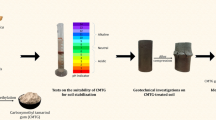Abstract
Several soil stabilization techniques have been adopted to favorably modify the geotechnical properties like hydraulic conductivity, strength, and compressibility of soil. In this study, xanthan gum (XG), an anionic bacterial extracellular polysaccharide is used to modify the geotechnical properties of the soil, particularly its strength and hydraulic conductivity. The addition of xanthan gum to soil improves its strength and stiffness and also decreases its hydraulic conductivity. The addition of xanthan gum induces polymer cross-linking, forms interconnected network of hydrogels in the voids of the soil matrix and causes preferential adsorption of the biopolymer molecules and cations on the soil surface. These interactions between the soil and the biopolymer alter the geotechnical properties of the treated soil matrix favorably. The decrease in permeability is nearly 1000 times with a small addition of 0.25% xanthan gum to the soil. Xanthan gum tends to aggregate the particles at lower concentration and at higher concentrations forms more viscous hydrogels that fill the pore spaces and clogs the pores. Strength also shows a similar increase and hence xanthan gum can be recommended for soil stabilization.








Similar content being viewed by others
References
Ayeldeen MK, Negm AM, El Sawwaf MA (2016) Evaluating the physical characteristics of biopolymer/soil mixtures. Arab J Geosci 9:371
Ayeldeen M, Negm A, El-sawwaf M, Kitazume M (2017) Enhancing mechanical behaviors of collapsible soil using two biopolymers. J Rock Mech Geotech Eng 9(2):329–339
Blanck G, Cuisinier O, Masrouri F (2014) Soil treatment with organic non-traditional additives for the improvement of earthworks. Acta Geotech 9(6):1111–1122
Bouazza A, Gates WP, Ranjith P (2009) Hydraulic conductivity of biopolymer-treated silty sand. Géotechnique 59(1):71–72
Cabalar AF, Wiszniewski M, Skutnik Z (2017) Effects of Xanthan gum biopolymer on the permeability, odometer, unconfined compressive and triaxial shear behavior of a sand. Soil Mech Found Eng 54(5):356–361
Chang I, Cho GC (2012) Strengthening of Korean residual soil with β-1,3/1,6-glucan biopolymer. Constr Build Mater 30(2):30–35
Chang I, Im J, Kharis A, Cho G (2015) Effects of Xanthan gum biopolymer on soil strengthening. Constr Build Mater 74:65–72
Chang I, Im J, Cho GC (2016) Introduction of microbial biopolymers in soil treatment for future environmentally-friendly and sustainable geotechnical engineering. Sustainability 8:251
Chen R, Zhang L, Budhu M (2013) Biopolymer stabilization of mine tailings. J Geotech Geoenviron Eng 139:1802–1807
Comba S, Sethi R (2009) Stabilization of highly concentrated suspensions of iron nanoparticles using shear-thinning gels of xanthan gum. Water Res 43(15):3717–3726
Dash SK, Hussain M (2012) Lime stabilization of soils: reappraisal. J Mater Civ En 24(6):707–714
Dehghan H, Tabarsa A, Latifi N, Bagheri Y (2019) Use of xanthan and guar gums in soil strengthening. Clean Techn Environ Policy 21(1):155–165. https://doi.org/10.1007/s10098-018-1625-0
DeJong JT, Soga K, Banwart SA, Whalle WR, Ginn TR, Nelson DC, Mortensen BM, Martinez BC, Barkouki T (2011) Soil engineering in vivo: harnessing natural biogeochemical systems for sustainable, multi-functional engineering solutions. J the Royal Soc Interface 8(54):1–15
Ivanov V, Chu J (2008) Applications of microorganisms to geotechnical engineering for bioclogging and biocementation of soil in situ. Rev Environ Sci Biotechnol 7(2):139–153
Khachatoorian R, Petrisor IG, Kwan CC, Yen TF (2003) Biopolymer plugging effect: laboratory pressurized pumping flow studies. J Pet Sci Eng 38:13–21
Kwon YM, Chang I, Lee M, Cho GC (2019) Geotechnical engineering behavior of biopolymer-treated soft marine soil. Geomech Eng 17(5):453–464
Latifi N, Marto A, Eisazadeh A (2015) Analysis of strength development in non-traditional liquid additive-stabilized laterite soil from macro- and micro-structural considerations. Environ Earth Sci 73(3):1133–1141
Latifi N, Horpibulsuk S, Meehan CL, Abd Majid MZ, Tahir MM, Mohamad ET (2016) Improvement of problematic soils with biopolymer—an environmentally friendly soil stabilizer. J Mater Civ Eng 29(2):1–11
Martin GR, Yen TF, Karimi S (1996) Application of biopolymer technology in silty soil matrices to form impervious barriers. In: 7th Australia New Zealand conference on geomechanics: geomechanics in a changing world: conference proceedings. Institution of Engineers, Australia, pp 814–819
Melton DL, Mindt L, Rees AD, Sanderson GR (1976) Covalent structure of the extracellular polysaccharide from Xanthomonascampestris: evidence from partial hydrolysis studies. Carbohydr Res 46:245–257
Nugent RA, Zhang G, Gambrell RP (2009) Effect of exopolymers on the liquid limit of clays and its engineering implications. Transport Res Rec: J Transport Res Board 2101(1):34–43
Plank J (2004) Applications of biopolymers and other biotechnological products in building materials. Appl Microbiol Biotechnol 66(1):1–9
Thangaraj R, Thenmozhi R (2013) Sustainable concrete using highvolume fly ash from thermal power plants. Ecol Environ Conserv 19(2):461–466
Tingle JS, Santoni RL (2003) Stabilization of clay soils with nontraditional additives. Transport Res Rec: J Transport Res Board 1819(1):72–84
Tran T P A, Im J, Cho G C (2017) Soil – water characteristics of xanthan gum biopolymer containing soils. In: Proceedings of the 19th International Conference on Soil Mechanics and Geotechnical Engineering, Seoul 2017, 1091–1094
Acknowledgments
The authors sincerely acknowledge the financial support from the University. Also, the authors would like to place on record sincere thanks to the Vice Chancellor for the motivation and infrastructure provided for completing this work. The authors would also thank sincerely the editor and the anonymous reviewers for their time and effort in helping us improve the manuscript.
Funding
This study is supported by the T.R.R scheme (TRR18) of the SASTRA Deemed University, Thanjavur, India.
Author information
Authors and Affiliations
Corresponding author
Ethics declarations
Conflict of interest
The authors declare that they have no conflict of interest.
Rights and permissions
About this article
Cite this article
Sujatha, E.R., Atchaya, S., Sivasaran, A. et al. Enhancing the geotechnical properties of soil using xanthan gum—an eco-friendly alternative to traditional stabilizers. Bull Eng Geol Environ 80, 1157–1167 (2021). https://doi.org/10.1007/s10064-020-02010-7
Received:
Accepted:
Published:
Issue Date:
DOI: https://doi.org/10.1007/s10064-020-02010-7




